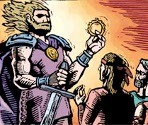Robin D. Laws's Blog, page 94
October 31, 2011
NeoExodus Fiction
 Speaking of crowdfunding, Louis J. Porter of Louis Porter Jr. Design Inc has enlisted me to write a fiction piece for the NeoExodus setting. The outcome of a Kickstarter campaign to launch LPJ's fiction line will determine its scope. Full details here.
Speaking of crowdfunding, Louis J. Porter of Louis Porter Jr. Design Inc has enlisted me to write a fiction piece for the NeoExodus setting. The outcome of a Kickstarter campaign to launch LPJ's fiction line will determine its scope. Full details here.
See P. XX
 For a look at how DramaSystem handles scene framing, check out my eponymous column in the brand-new edition of Pelgrane Press' webzine, See P. XX.
For a look at how DramaSystem handles scene framing, check out my eponymous column in the brand-new edition of Pelgrane Press' webzine, See P. XX.
Among other included goodies are Adrian Bott's look at the upside of failure, Steve Dempsey's Trail of Cthulhu demo "Ritual Pursuits", an assortment of Ashen Stars and ToC wallpapers, and a build-it-yourself apocalypse. Check it out!
October 28, 2011
Crowdfunding and You
 Usually a single person's buying preferences mean little in the grand sweep of a product roll-out. This doesn't stop us from ascribing our desires to large numbers of other people when we wish an item was priced differently or had some other suite of features.
Usually a single person's buying preferences mean little in the grand sweep of a product roll-out. This doesn't stop us from ascribing our desires to large numbers of other people when we wish an item was priced differently or had some other suite of features.
Crowdfunding changes all that. It allows a single person, by financing a goodly chunk of a project's expenses, to become a significant portion of its market. Though no one thinks of it in this way, that's one of the movement's primary appeals: it ushers you into a realm of statistical significance. For once, your anecdotal data about your own purchasing history is relevant!
Simon Rogers and I are currently mulling the various perks we might offer as we crowdfund Hillfolk, the first DramaSystem game. With that in mind, I thought I'd pick the brains of those of you who have contributed to crowd-funded projects.
My assumption is that most people who contribute do so because they want a copy of the product being offered, and want to feel that they're helping to bring it into existence. According to this thoroughly uncontroversial theory, the most compelling perk would obviously be the book itself, in both a modest and a premium version. Being credited in the book and elsewhere as a funder, I am also assuming, is another key incentive.
Aside from these central pillars of crowdfunding, are there other perks you've found particularly enticing? Conversely, what perks arouse your indifference? Are there perks that once inspired you to pledge, but have since paled in your estimation?
I'm not going to shoot you with my comment gun if you've put up a project for crowdfunding and have insights to share about the process. However, I am hoping for discussion primarily led by pledgers, past and future.
October 27, 2011
The Birds: Make Sure
Click here for the complete strip archive.
Stuck in mobile mode? Click here for image file.
October 26, 2011
Toppled Silo
 King of Dragon Pass sold as many units in its first six weeks of release as the game's desktop incarnation did over its entire lifetime. As Sarah Newton pointed out over on the Twitter:
King of Dragon Pass sold as many units in its first six weeks of release as the game's desktop incarnation did over its entire lifetime. As Sarah Newton pointed out over on the Twitter:
I guess it just shows the difference in reach once you break out of the "silo" into the global app market.
I think that's exactly right. Moreover, KoDP serves as an exemplar of a shift in marketing eras. Back in the old-timey mists of 1999, computer games were items primarily sold in brick and mortar stores, packaged in largish cardboard boxes full of nothing. These stores ran on a pay for placement basis, renting out prime endcap space to manufacturers. Glossy magazines provided the main avenue of promotion. To snag coverage, you had to fit within one of four sharply delineated categories. King of Dragon Pass, with its mixture of storytelling and resource management, is and was sui generis. In the era of silos, originality turned out not only to be a minus, but a powerful barrier to entry.
Today we have shifted from the silo era to the recommendation era. Computer games are digital files sold through portals for whom a wide assortment of categories and deep stock are competitive advantages. Through social networking, creators can alert core customers for a niche game like KoDP to the portal, and let it do the rest. The portal provides the opportunity to break out of the niche. New players who have never rolled a d20 and have no idea who Greg Stafford is are now discovering the world of Glorantha.
And not all of them are even Scandinavian.
October 25, 2011
Paparazzo Drift
 Like most governments, South Korea keeps more regulations on the books than it can afford to police. Its solution: offer small bounties to private citizens who report commercial infractions. The result: a growing industry of so-called "paparazzi" who, with video cameras in hand, act as freelance inspection officers. (NYT link.)
Like most governments, South Korea keeps more regulations on the books than it can afford to police. Its solution: offer small bounties to private citizens who report commercial infractions. The result: a growing industry of so-called "paparazzi" who, with video cameras in hand, act as freelance inspection officers. (NYT link.)
First, this presents us with a lovely example of linguistic drift. The term paparazzi originates in a work of fiction, the iconic Federico Fellini film La Dolce Vita, in which a photographer who hunts local celebrities and gossip figures with his camera is nicknamed Paparazzo—which means buzzing fly. It soon entered the English language, transmuted into a general term for celebrity-stalking photographer. And now it has mutated again, moving to Korea to describe these for-profit regulators.
South Korea's film industry has been on a roll lately, turning out great genre flicks. How long will it be before this real-life situation, rife with cinematic promise, supplies the premise for a movie—and what genre will it tackle?
Crime drama: A budding regulator winds up over his head when he records the wrong infraction at a mob-owned factory.
Spy thriller: A paparazzi flees North Korean agents when his tape of food stall infractions accidentally captures their activities.
Comedy: The cat and mouse game between a paparazzi and his business owner target turns into an escalating series of reprisals.
Romantic Comedy: An unlikely pair of freelance regulators fall in love when they compete to expose the same dumping scam.
Horror: Terror abounds when a team of young paparazzi discover that the secret hidden of an abandoned factory is something far worse than drums of toxic waste...
October 24, 2011
The Bit.ly Info Page Is Your Friend
 Here's a plug for a tool I've found very useful in calibrating my net presence. If yours includes links, and constitutes an outreach effort of some kind—that is, you care how many people respond to your links by clicking on them—you may find it equally helpful.
Here's a plug for a tool I've found very useful in calibrating my net presence. If yours includes links, and constitutes an outreach effort of some kind—that is, you care how many people respond to your links by clicking on them—you may find it equally helpful.
We all know the main purpose of link shorteners. Before Twitter embedded its own URL-shrinker in its interface, bit.ly was clearly the leader in the field. I still find it the service to use, because of the metrics it gives you when you create a link while signed into their site. If you add their bookmarklet to your browser, you get a fast way to generate links from pages, which then propagate to Twitter and Facebook. One presumes that Google+ will join the list when its API goes public.
The bookmarklet gives you a handy 140-character editing window and allows you to pick thumbnails for Facebook.
The thing I'm finding really useful about bit.ly is the ability to go to a list of one's links, in what is called your public timeline, and see how popular each item has been. For each link you can consult an info page that lists other Twitter cites, tells you when clicks occurred, and from what platform.
It was through these info pages that I first saw how effective Google+ was in driving attention, even a few weeks into its launch. Though I'm sometimes surprised by how much (or how little) mileage a given link gets, it provides an ongoing reminder of the sorts of subjects my readers are interested in—or not.
Those who link purely out of self-expression won't find much to care about here, unless they feel irresistibly drawn to pie charts. But if you link to your own blog or other articles to maintain a profile or get a message out, your bit.ly timeline will assist in fine-tuning your choices.
October 21, 2011
The Birds: Ultra-Complicated
October 20, 2011
How a DramaSystem Episode Plays Out
 Last week I presented a series of synopses from the in-house Hillfolk playtest, to show the sort of narrative you might develop over the course of a DramaSystem series. This time I thought I'd zoom in a bit with a detailed account of the action that unfolds during a single episode.
Last week I presented a series of synopses from the in-house Hillfolk playtest, to show the sort of narrative you might develop over the course of a DramaSystem series. This time I thought I'd zoom in a bit with a detailed account of the action that unfolds during a single episode.
This is from our second season. For list of main characters, pop back here. We've now added a new PC, the warrior Flint (played by Scott.) He's returned to the Horsehead clan after a year's captivity at the hands of the loathed and feared neighboring people, the Tridents. Though still finding his footing in a home that has greatly changed during his absence, he'll soon start acting on his dramatic poles: loyalty vs. ambition. Close readers will note that this is the same opposition that drove the chieftain, Thickneck, during the first season. His player is away attending classes this fall, so I've had to step in to play him as a recurring character. Other characters not mentioned in the above-linked post are also recurring characters, played by the GM.
The episode title is also its theme, chosen by the player who frames, or calls, its first scene.
SE02EP03: "Unity"
Skull seeks the cooperation of Staffholder, the child shaman who now serves as the clan's spiritual advisor, in his bid for southern unity. She embraces his plan enthusiastically, thinking it will allow them to impose Horsehead-style worship on the region—by violence if necessary.
Flint dreams of the torturer who loved him, the cruelly beautiful Trident matriarch Pierces-the-Sky. He awakens in horror.
Twig seeks her husband's plans for the coming moot, where southern clans open to unifying under the northern king will meet to mull the details. Thickneck provides slim assurance, revealing that opposed clans and rebel bandits likely intend to attack the moot or the northern procession to it.
At a meeting of the inner circle, Redaxe demands a clear long-range objective for the clan. Thickneck agrees to his scheme to unify north and south against the Tridents.
Flint confronts Farhawk, demanding to know what he must do to prove he's not a spy. Farhawk reveals that Skull was until recently making overtures to the Tridents, and advises Flint to kill him.
Farhawk goes to his wife, Raging River, for a dose of realpolitik. She lays out a chilling vision in which all choices lead to civil war.
Skull seeks Redaxe's aid at the moot. They hatch a plan to parley with their mightiest rivals, the Stoneforts.
Godtalker, a northern priest invited to Horsehead by Twig, petitions her for redress, after the northerner's sacred tablets are profaned by someone throwing dung. She agrees to find the culprit.
It's a young woman, perhaps put up to it by Staffholder. Twig goes to Godtalker seeking forgiveness for her. Godtalker compromises from his original demand that she be stoned, instead jumping at the chance to deliver an exhortation to the entire moot.
Redaxe meets Oldcrag, his opposite number among the Stoneforts, and finds him less interested in fighting Tridents than his traditional foes, the Horseheads.
Flint demands that Skull tell him the truth about his Trident dalliances. Skull placates him, minimizing the consequences of his prior meeting with the dread Trident warrior, Tall-As-A-Spear.
A religious riot pits Horseheads against Northerners. In its aftermath, Farhawk upbraids Twig for starting the whole mess, by inviting in Northern priests. She vehemently defends her actions.
Skull seeks out Thickneck, who turns out to be equally disturbed by his wife's spiritual meddling. He appoints Skull as the man to solve the strife.
October 19, 2011
New Hero Cover Revealed
Here's a peek at the cover for The New Hero. As you'll recall, this is the first of the fiction anthologies I'm shepherding for Stone Skin Press, Pelgrane's new fiction line. We were lucky enough to snag the services of comics artist and illustrator extraordinaire Gene Ha, who more than met our expectations with the fabulous image you see below.

Gene went above and beyond the call of duty by closely reading each and every one of the fourteen great stories in the collection, placing each protagonist in his composition. He pitched us the idea of a Greek vase as emblematic of the book's theme, which combines the time-honored structure of the iconic hero tale with fresh new characters, settings, and voices. The individual elements will also appear in the interior, as part of the title treatment for each story.
The first volume of a new line carries a lot of freight. We couldn't be more thrilled.




